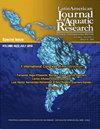利用Schnute模型估计原雌雄同体海洋腹足动物Trochita trochiformis (Littorinimorpha: Calyptraeidae)的差异生长
IF 0.8
4区 农林科学
Q3 FISHERIES
Latin American Journal of Aquatic Research
Pub Date : 2023-07-02
DOI:10.3856/vol51-issue3-fulltext-3016
引用次数: 0
摘要
蜗牛Trochita trochiformis是一种在墨西哥太平洋哈利斯科州和格雷罗州海岸捕获的软体动物。尽管它在手工渔业中很重要,但关于其人口参数的资料仍在确定之中。本研究旨在确定该物种的径重关系、性别比、队列和生长。标本于2019年10月至2021年9月捕获。收集了1763只雌虫和956只雄虫的壳径(Sd)、总重(Tw)和性别。性别比为1.84:1,经X2检验,差异有统计学意义(P < 0.05)。雌性和雄性的Sd-Tw关系为潜在型。两性异速生长系数b = 2.61,雌性b = 2.60,雄性b = 2.62。在这三种情况下,t-Student检验均显示负异速生长,这表明该物种首先在壳直径上生长,然后在体重上生长。经ANCOVA分析,Sd-Tw关系在两性间无显著差异(P = 0.902)。对Sd数据应用Kolmogorov-Smirnov检验显示性别之间存在差异(P < 0.001)。在女性中,每月比较有71.5%的差异,而在男性中,有58.1%的差异。多项分析显示有3个模态组和14个单独的男性和女性队列。病例2为Schnute模型,雌性(wi = 0.39)和雄性(wi = 0.53)最佳,呈s形gompertz型生长。生长曲线显示,雌鱼的生长速度比雄鱼快,雌雄鱼在10岁左右分别达到最大尺寸88.04 mm和86.23 mm。本文章由计算机程序翻译,如有差异,请以英文原文为准。
Estimation of differential growth of the protandrous hermaphrodite marine gastropod Trochita trochiformis (Littorinimorpha: Calyptraeidae) using Schnute model cases
The snail Trochita trochiformis is a mollusk captured on the coasts of Jalisco and Guerrero of the Mexican Pacific. Despite its importance in artisanal fisheries, information on its population parameters is still being determined. This research aimed to determine the diameter-weight relationship, sex ratio, cohorts, and growth of this species. Specimens were captured from October 2019 to September 2021. Shell diameter (Sd), total weight (Tw), and the sex of the organisms were gathered from a total of 1763 females and 956 males. The sex ratio was 1.84:1, and the X2 test (P < 0.05) indicated significant differences. The Sd-Tw relationship for females and males was potential-type. The values of the allometry coefficient for both sexes were b = 2.61, b = 2.60 for females, and b = 2.62 for males. In all three cases, the t-Student test indicated negative allometric growth, which indicates that the species first grows in shell diameter, then in body weight. The ANCOVA did not show significant differences in the Sd-Tw relationships between sexes (P = 0.902). The Kolmogorov-Smirnov test applied to the Sd data showed differences between sexes (P < 0.001). In females, differences were observed in 71.5% by monthly comparisons, while in males, differences were found in 58.1%. Multinomial analysis showed three modal groups and 14 individual cohorts for both females and males. Case 2 of the Schnute model was the best for females (wi = 0.39) and males (wi = 0.53), showing sigmoidal Gompertz-type growth. The resulting growth curves showed that females exhibit accelerated growth concerning males and that both sexes reach their maximum size, 88.04 and 86.23 mm, respectively, at approximately 10 years of age.
求助全文
通过发布文献求助,成功后即可免费获取论文全文。
去求助
来源期刊

Latin American Journal of Aquatic Research
FISHERIES-MARINE & FRESHWATER BIOLOGY
CiteScore
1.70
自引率
10.00%
发文量
44
审稿时长
4-8 weeks
期刊介绍:
Latin American Journal of Aquatic Research- LAJAR is the continuation of the journal Investigaciones Marinas (1970-2007) and is published since 2008 by the Escuela de Ciencias del Mar, Facultad de Ciencias del Mar y Geografía of the Pontificia Universidad Católica de Valparaíso. LAJAR is an “Open Access” journal that publishes in English language, original research articles, reviews and short communications on aquatic science, which contain the results of research conducted in aquaculture or in oceanic and coastal marine waters of Latin America.
The following topics are considered: Physical Oceanography, Chemical Oceanography, Marine Biogeochemistry, Marine Pollution and Toxicology, Marine Geology and Geophysics, Biological Oceanography, Fisheries and Aquaculture.
 求助内容:
求助内容: 应助结果提醒方式:
应助结果提醒方式:


